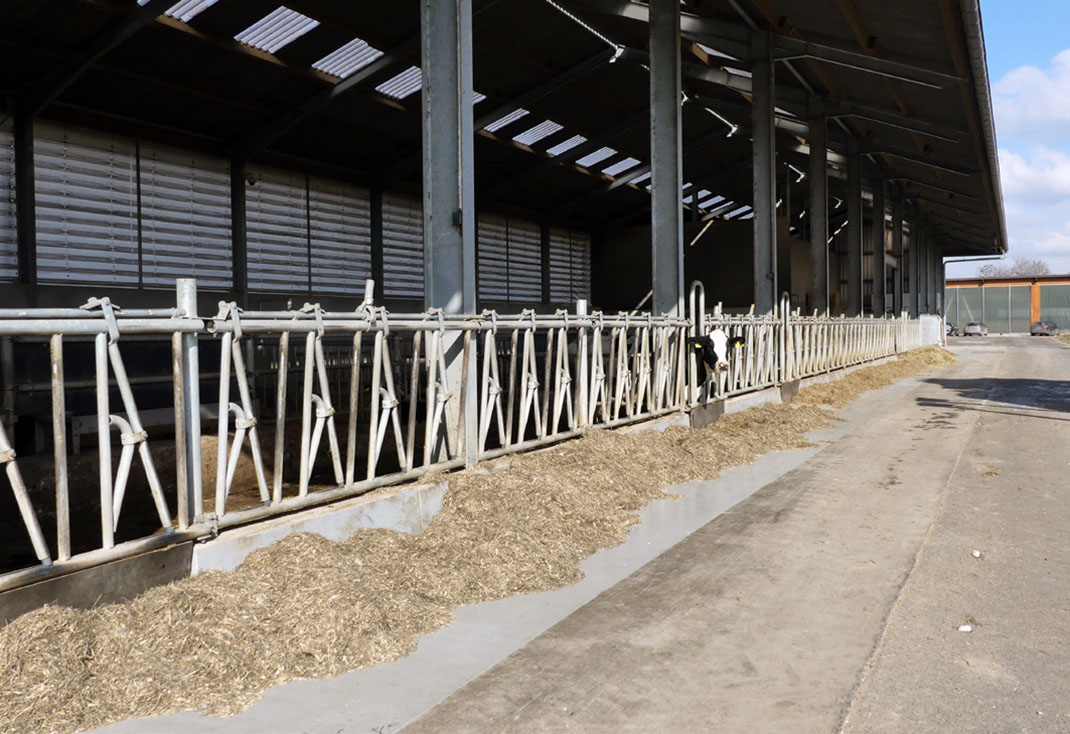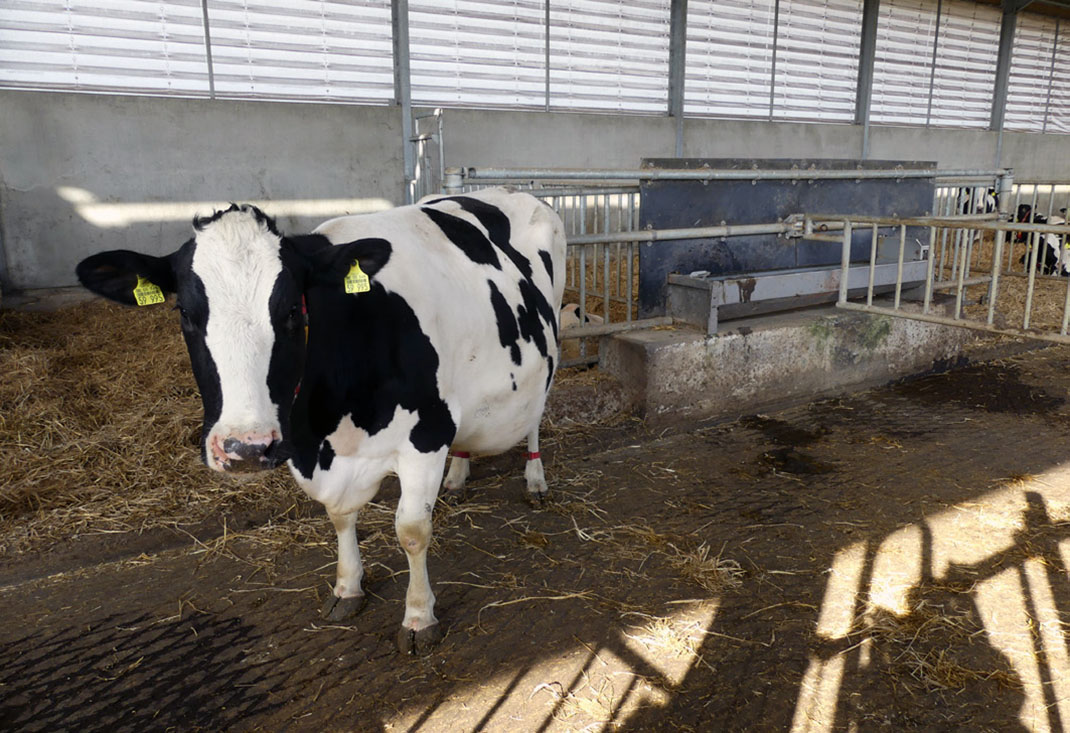"We can now identify cows on heat better and sooner than before”
Who?
Christoph Philippen
Farm manager
Where?
Heinsberg, Germany
About the farm
- 200 dairy cows and 200 youngstock
- Average production 10.400 kg milk with 4.43% fat and 3.45% protein
- 115 hectares of land under grass, corn, cereals, sugar beet
- Implemented Nedap COWcontrol™ through Semex AI24
Nedap solutions
Results
Over the past year, the Philippen family’s dairy farm in Heinsberg has invested in a heat detection system with built-in health monitoring. How has fertility management improved since?
The Philippen dairy farm in Heinsberg, south-west Germany on the edge of the Ruhr valley, has undergone remarkable development in the last 13 years. In 2005, the Philippen family expanded from 40 tethered cows at the time to 120 cows and set up a new barn in open pasture 11 km from the old site. When the family’s son and current farm manager, Christoph Philippen, joined the company in 2014, the family expanded the barn to what is now 200 cows. The herd’s current milk yield is 10,400 kg on average.

Growth requires digital technology
To meet the increasing growth-related demands on management, in June 2017 the farm invested in a heat detection system with built-in health monitoring to optimise farm fertility management and more effectively prevent health problems. The Semex AI24 system with Nedap technology is attached to the cow’s collar in the form of so-called Smarttags that contain sensors and measure not only activity (movement and registration of oestrus signals) but also monitor health based on eating and rumination habits.
The system receives data on individual animals via the antenna in the barn. Twice a day, in the morning before and after milking, the Philippen family monitors in the system (either via computer or smartphone) which cows are on heat based on the activity curve. After that, an insemination technician from Rinder-Union West eG (RUW) comes in the morning and inseminates two to three animals a day.
Farm manager Christoph Philippen:
“The system has saved us a lot of man hours since it was introduced because we can now identify cows on heat better and sooner than before.”
Key data
The Semex AI24 system is linked to the herd management programme of the company Uniform Agri. Periodic synchronisations occur at regular intervals. According to the manufacturer, the system is also compatible with all other conventional herd management programmes (e.g. Herde, Dairy Plan C 21 and DairyComp). The range of the antenna in the barn is around 75 meter. With the antenna, the construction of the barn matters more than the number of cows. The system can also be used when putting out to pasture for the grazing land using a larger outdoor antenna. The service life of the batteries and smart tags is eight to ten years depending on the manufacturer.

The Philippen family farm last expanded its production pen by 80 places in 2014 and also built a new calf pen (left).
Increase the heat detection rate – problems become more quickly recognisable
Before the company invested in the system, heat detection was done visually by regular observation in the barn, which required a lot of time and close monitoring. “We would sometimes miss a cow or spot it too late, so we had to inject more often,” says the young farm manager.
Thanks to the new heat management system, the Philippen family has been able to increase the heat detection rate (HTR) from 56 percent to 71 percent. The inter-calving period (ICP) has also been reduced from 384 to 373 days. The voluntary waiting period (VWP) is currently 60 days. However, the farm manager is considering increasing it again by around ten days in future so that high-yielding cows can be milked for longer.
Every fortnight, the farm vet examines the herd for pregnant cows. The number of non-pregnant animals has since fallen sharply. Digital heat detection identifies non-pregnant cows faster than the naked eye, so new insemination can take place sooner. Even if an animal remains on heat on the day after insemination, Philippen has direct insight into this. The animal is then subsequently directly inseminated as necessary.
On days following hoof care, the system sometimes identifies more animals as being on heat than actually are, as the herd is more active then. Already pregnant cows are rarely identified as being on heat; however, the activity curve shows only a slight fluctuation and Philippen realises that it is merely an indication of increased activity rather than oestrus. “Overall, however, it is very rare for the system to mistakenly identify animals as being on heat,” says Philippen.

Through simultaneous health monitoring based on eating and rumination habits, udder diseases, for instance, can be detected at an early stage because feed intake or rumination activity usually decreases. “Cows that eat less before calving are often seen as problem cows after calving,” says Philippen.
Farm manager Christoph Philippen:
“Now we can react faster. In the past, we often didn’t detect problems like this until two or three days later.”

The outdoor transit pen is divided into three functional areas with a preparatory, calving and recently calved cow pen.

The two calving bays of the transit pen are mirrored and provide enough space for two to three cows.
Smarttags for cattle too
For the first time, the cows are now given the smart tags with built-in health monitoring after their first calving in the calving pen, which is attached externally to the production pen. From then on, the smart tags stay on each cow while it is on the farm. The open transit pen with outside feeding table is divided into three functional areas. On the left, there is a bay for the preparatory group, two calving bays are housed in the middle and to the right is the barn for recently calved cows. Recently calved cows are monitored daily for fever and ketosis. These calved cows stay there for around ten days and are always led into the milking parlour at the end.
For cattle housed in the old site until they calve the first time, there is an insemination group which also has smart tags. However, these sensors only measure pure activity or feeding duration, without additionally monitoring health. The farm can also have the cattle completely inseminated; there is no stud. The age of first calving (AFC) on the farm is 24.3 months on average.

The calf pen, built in 2014, is divided into three groups: the first two groups are located on the automatic feeder, and the final one is already set down.
Labour savings
For the investment in the heat detection system with health monitoring, the Philippe family spent around 100 Euros per cow. Overall, the heat detection rate has increased significantly so far, and the inter-calving age and lactation days have declined. In addition, the cows are not as fat at insemination as before because insemination takes place sooner. Injection is also less often required because oestrus is detected faster.
Farm manager Christoph Philippen:
“We’re very happy with the heat detection system so far because it makes our work a lot easier.”
Search results for: ''
There are no results matching your criteria. Please try again with different criteria.